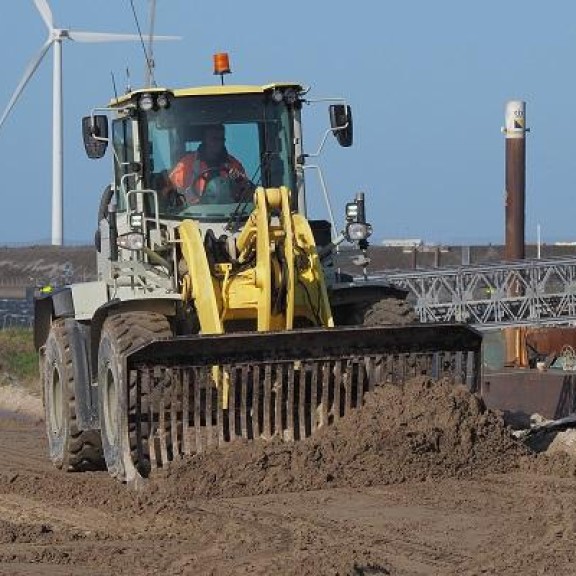
The sand depot of the new sea lock in IJmuiden
The new sea lock will be completely dredged out and all this sand will have to go somewhere. How does this work? What are they doing with all this sand? Arjan Kroot, site manager of the lock complex, explained the working techniques used on the construction site.
Arjan's special responsibility within the new sea lock project is dredging and the moving or removing of soil.
Sand is moved from here to there and back again
Eventually, the western part of the Middle Lock Island is to be removed to become the future approach channel to the new sea lock. Until that time, and because there is enough space for it, the western part of the Middle Lock island is being used as a temporary sand depot. Arjan explained, "When we excavate areas for concreting works, we have to store the excavated sand somewhere else. That's how the sand depot came into being. We continually move and remove sand to and from the sand depot. We have already brought 300,000 m3 to it and removed 120,000 m3 from it to other areas and have dumped another 180,000 m3 at a location at sea. We still have some 2.2 million m3 of sand to remove from the depot. All the sand will eventually be transported to sea and dumped at the dumping area."
Only clean sand may be dumped at sea
All the sand in the work area has been certified. "We've carried out all kinds of soil surveys all over the work area. The quality of the sand has been measured. We have removed soil that was contaminated and what now remains is clean sand and this we are allowed to dump at sea at the dumping area."
Before the western part of the Middle Lock island can be excavated, we must clear the soil of all 'hard' materials.
Loading bridge ‘De Leeuw’
Sand is being removed both above water and under water. Arjan illustrated how both techniques work. "Above the groundwater table we work with machinery such as, cranes, dumpers and shovels. If we have sand left over which we cannot use for replenishment work elsewhere, we will transport it to sea in a so-called split barge. A split barge is a large barge in which we collect all the sand. Dumpers dump their cargo into the split barges from loading bridge 'De Leeuw'. Split barges have a capacity of 900 m3. As soon as the barge is full, it will be towed to sea by a tugboat. The sand will be dumped at sea after which the whole process will start all over again."
Cutter dredger ‘Biesbosch’
The underwater removal of sand is a slightly different process. "The sand below the water line will be dredged away by a cutter dredger and a hopper dredger. We have dredged an underwater pit in the outer approach channel to the North Lock. The approach channel has a depth of 18 metres below NAP. Because the underwater pit is deeper than the approach channel, there will be no hindrance to shipping traffic. Cutter dredger ‘Biesbosch’ will dredge away the upper layer up to a depth of 8 metres below NAP and will dump the sand into the pit. The hopper dredger will then remove the sand from the pit and will dump it at sea. The pit can contain up to 50,000 m3 of sand. In contrast to the split barge, which has to be towed, the hopper dredger has its own propulsion system."
Cooperation with the region
Arjen works closely with companies in the region. "We have a lot of contact with companies for soil survey. We work in close cooperation with the Waterway Manager and the ports of IJmuiden and Amsterdam to keep the waterway clear at all times. We try to do that in good consultation through our Maritime Coordinator to guarantee minimal disruption to shipping traffic. Luckily, no unexploded ordnance has yet been found on the site, so there has been no disruption to port companies either."